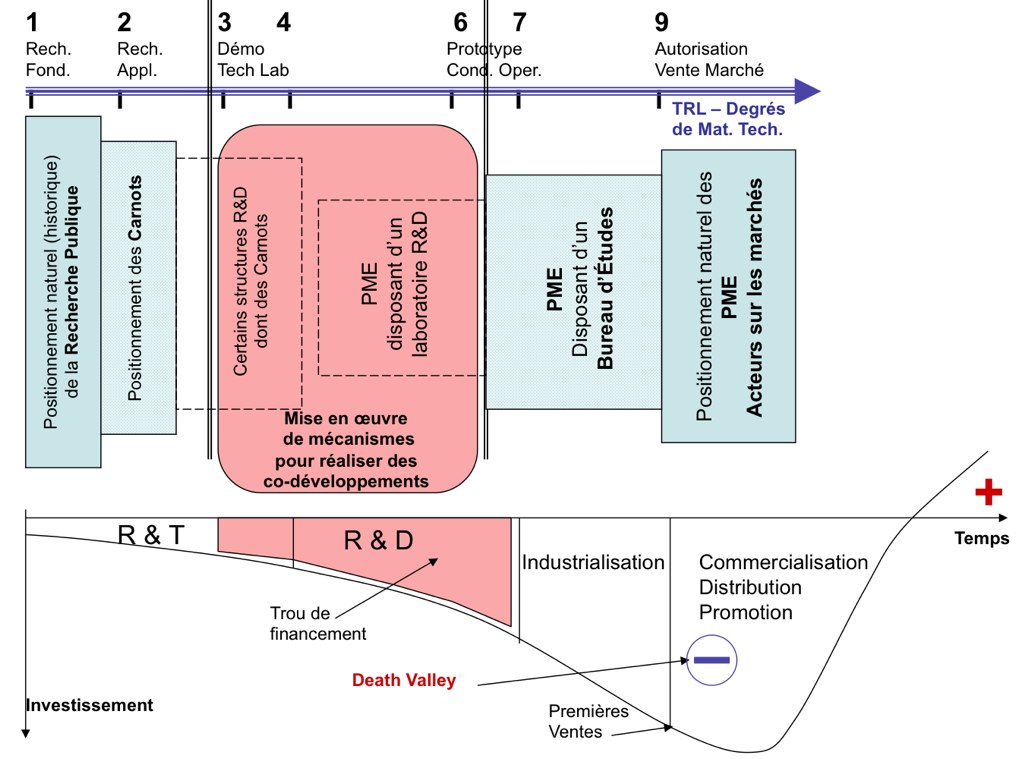At the Roundtable “SMEs: how to integrate advanced technologies, in partnership with public research” held at the “RDV Carnot” on May 5th and 6th in Lyon, Florin Paun, Deputy Director for Industrial Innovation at ONERA, explained why “the French research is not wired for innovation”.
TRLs
After a few provocative remarks, Florin Paun, explained the concept of Technology Readiness Level. It is a concept widely used in the aerospace and defense sectors that helps to qualify the level of maturity of a technology.
“Technology Readiness Level (TRL) is a measure used by some United States government agencies and many of the world’s major companies (and agencies) to assess the maturity of evolving technologies (materials, components, devices, etc.) prior to incorporating that technology into a system or subsystem.” (Wikipedia).
French research in the TRL scale
As shown in the Figure “TRLs and French research”, TRLs range from 1 to 9. TRL 1 is basic research, TRL 2 is applied research, TRL 3 and 4 correspond to a demonstrator in the laboratory, TRL 6 and 7 correspond to a prototype and TRL 9 is a technology ready to be released on the market.
The natural (historic) positioning of the vast majority of public research laboratories is located in very low levels of TRL (1 and 2). Carnot institutes are located a little higher in the scale of TRL and some of them even reach TRL 4. CETIM, repeatedly cited by Florin Paun, is also capable of rising high enough in the TRLs.
Attracting industry, especially SMEs, would require that the public research technologies reach at least TRLs of 4 or 5.
“The techno-push with TRL less than 4 are not relevant to industry.”
Why stay so low in TRL?
When he was studying in a French Grande Ecole, he was always struck by its motto, said Florin Paun.
“For the Nation, Science and Glory … and? Isn’t there something missing? For value, perhaps!?”.
There is a cultural block, french peolpe are somewhat ashamed to talk about money.
Need translation
Another aspect which was highlighted by Florin Paun is the existence of several imbalances between public research and SMEs.
- A relationship imbalance: public research and SMEs do not speak the same language. There is a need for translation, reformulation of the needs of SMEs and solutions provided by research laboratories.
- A financial and temporal imbalance: while SMEs take financial risks by setting up research contracts with laboratories, researchers, meanwhile do not face the same constraints of time.Motivations, simply are not the same (see our articles on research-industry collaborations Part 1 and Part 2).
“Imbalance create value, but this imbalance needs to be compensated to capture the value”.
One of the missions of the SATTs (Technology Transfer Acceleration Firms), recently introduced by the French Government, will be to compensate these two imbalance.
Conclusion
“SMEs, go and see the Carnot Institutes!”





L’expérience de l’innovation sur le terrain m’a montré que les instituts Carnot ne sont pas les meilleurs vecteurs pour établir des liens entre les créateurs de valeurs (PME et entreprises) et les laboratoires. Les innovateurs en PME, pour se lier aux laboratoires afin d’innover, utilisent plus facilement des organisations facilitatrices de proximité comme les organisations issues des conseils régionaux (Bretagne Innovation, SEM…) ou les syndicats professionnels (SYMOP, SYROBO…). Ces organisations connaissent les chercheurs qui savent parler aux patrons de PME et comprendre leur besoin.
After 41 year in aerospace development both in industry and space agency I can only agree with Florin Paun. Only the large companies can take benefit of french research labs. SME cannot afford to invest on low TRL.
1- I observed that scientist are rarely interested in TRL beyond 3, and the reason is that at that point, any publication on the subject is no longer new science worth article in major scientific journal (scientist are evaluated on how many new scientific publication he produces).
I am not sure that Carnot institutes are differents from other scientific institutions.
2- CNRS rules before signing contracts with industry are close to legal ransom ripping industry from ownership of the outcome of cooperation.
Bright scientific ideas and rewarded by scientific publication and recognition from the scientific community, but pre-emptive claim of ownership of the outcome of industrialisation is basically ignoring that most of the development cost and effort to bring the “idea” to the real world is born by industry.
Research institutions should should ask themself “If industry does not own the end product, why should it invest in it?”
3- To change the situation, research labs should be also evaluated on how many discoveries/ideas end up in real products.
A rule of thumb of development cost is:
1% on TRL 1-2 (research)
4% on TRL 3-4 (validation)
10% on TRL 5-6 (realistic prototyping)
85% for industrialisation!
Reward should be proportionate to the cost…
Dear Robert, thank you for this very inspiring feedback. You should read this other post on counter-productive public policies. Best. Albert
http://open-organization.com/2012/01/29/open-innovation-and-public-policies-in-europe/